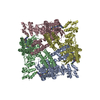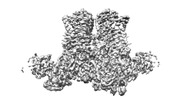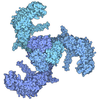+ Open data
Open data
- Basic information
Basic information
| Entry |  | |||||||||
|---|---|---|---|---|---|---|---|---|---|---|
| Title | Structure of human TRPV4 with antagonist A2 and RhoA | |||||||||
 Map data Map data | ||||||||||
 Sample Sample |
| |||||||||
 Keywords Keywords | Channel / MEMBRANE PROTEIN | |||||||||
| Function / homology |  Function and homology information Function and homology informationstretch-activated, monoatomic cation-selective, calcium channel activity / blood vessel endothelial cell delamination / regulation of response to osmotic stress / osmosensor activity / vasopressin secretion / calcium ion import into cytosol / negative regulation of brown fat cell differentiation / positive regulation of microtubule depolymerization / positive regulation of striated muscle contraction / positive regulation of macrophage inflammatory protein 1 alpha production ...stretch-activated, monoatomic cation-selective, calcium channel activity / blood vessel endothelial cell delamination / regulation of response to osmotic stress / osmosensor activity / vasopressin secretion / calcium ion import into cytosol / negative regulation of brown fat cell differentiation / positive regulation of microtubule depolymerization / positive regulation of striated muscle contraction / positive regulation of macrophage inflammatory protein 1 alpha production / hyperosmotic salinity response / positive regulation of chemokine (C-X-C motif) ligand 1 production / positive regulation of chemokine (C-C motif) ligand 5 production / cartilage development involved in endochondral bone morphogenesis / alpha-beta T cell lineage commitment / aortic valve formation / mitotic cleavage furrow formation / positive regulation of lipase activity / bone trabecula morphogenesis / endothelial tube lumen extension / skeletal muscle satellite cell migration / positive regulation of vascular associated smooth muscle contraction / angiotensin-mediated vasoconstriction involved in regulation of systemic arterial blood pressure / SLIT2:ROBO1 increases RHOA activity / RHO GTPases Activate Rhotekin and Rhophilins / Roundabout signaling pathway / negative regulation of intracellular steroid hormone receptor signaling pathway / Axonal growth inhibition (RHOA activation) / Axonal growth stimulation / cellular hypotonic salinity response / cleavage furrow formation / cellular hypotonic response / regulation of neural precursor cell proliferation / cortical microtubule organization / regulation of modification of postsynaptic actin cytoskeleton / regulation of osteoblast proliferation / forebrain radial glial cell differentiation / multicellular organismal-level water homeostasis / regulation of modification of postsynaptic structure / cell junction assembly / apical junction assembly / negative regulation of cell migration involved in sprouting angiogenesis / cellular response to chemokine / establishment of epithelial cell apical/basal polarity / positive regulation of vascular permeability / beta selection / regulation of systemic arterial blood pressure by endothelin / osmosensory signaling pathway / negative regulation of oxidative phosphorylation / negative regulation of motor neuron apoptotic process / RHO GTPases activate CIT / RHO GTPases Activate ROCKs / negative regulation of cell size / cell-cell junction assembly / positive regulation of monocyte chemotactic protein-1 production / PCP/CE pathway / Sema4D induced cell migration and growth-cone collapse / RHO GTPases activate KTN1 / calcium ion import / cell volume homeostasis / cellular response to osmotic stress / positive regulation of podosome assembly / positive regulation of alpha-beta T cell differentiation / Sema4D mediated inhibition of cell attachment and migration / apolipoprotein A-I-mediated signaling pathway / wound healing, spreading of cells / positive regulation of leukocyte adhesion to vascular endothelial cell / PI3K/AKT activation / odontogenesis / Wnt signaling pathway, planar cell polarity pathway / motor neuron apoptotic process / ossification involved in bone maturation / regulation of focal adhesion assembly / regulation of aerobic respiration / negative chemotaxis / TRP channels / EPHA-mediated growth cone collapse / apical junction complex / cortical actin cytoskeleton / stress fiber assembly / androgen receptor signaling pathway / diet induced thermogenesis / positive regulation of macrophage chemotaxis / myosin binding / positive regulation of cytokinesis / RHOC GTPase cycle / regulation of neuron projection development / cellular response to cytokine stimulus / cerebral cortex cell migration / ERBB2 Regulates Cell Motility / microtubule polymerization / semaphorin-plexin signaling pathway / calcium ion import across plasma membrane / cleavage furrow / ficolin-1-rich granule membrane / positive regulation of protein serine/threonine kinase activity / negative regulation of cell-substrate adhesion / RHOA GTPase cycle / mitotic spindle assembly / response to mechanical stimulus Similarity search - Function | |||||||||
| Biological species |  Homo sapiens (human) / synthetic construct (others) Homo sapiens (human) / synthetic construct (others) | |||||||||
| Method | single particle reconstruction / cryo EM / Resolution: 3.44 Å | |||||||||
 Authors Authors | Fan J / Lei X | |||||||||
| Funding support |  China, 1 items China, 1 items
| |||||||||
 Citation Citation |  Journal: Adv Sci (Weinh) / Year: 2024 Journal: Adv Sci (Weinh) / Year: 2024Title: Structural Pharmacology of TRPV4 Antagonists. Authors: Junping Fan / Chang Guo / Daohong Liao / Han Ke / Jing Lei / Wenjun Xie / Yuliang Tang / Makoto Tominaga / Zhuo Huang / Xiaoguang Lei /   Abstract: The nonselective calcium-permeable Transient Receptor Potential Cation Channel Subfamily V Member4 (TRPV4) channel regulates various physiological activities. Dysfunction of TRPV4 is linked to many ...The nonselective calcium-permeable Transient Receptor Potential Cation Channel Subfamily V Member4 (TRPV4) channel regulates various physiological activities. Dysfunction of TRPV4 is linked to many severe diseases, including edema, pain, gastrointestinal disorders, lung diseases, and inherited neurodegeneration. Emerging TRPV4 antagonists show potential clinical benefits. However, the molecular mechanisms of TRPV4 antagonism remain poorly understood. Here, cryo-electron microscopy (cryo-EM) structures of human TRPV4 are presented in-complex with two potent antagonists, revealing the detailed binding pockets and regulatory mechanisms of TRPV4 gating. Both antagonists bind to the voltage-sensing-like domain (VSLD) and stabilize the channel in closed states. These two antagonists induce TRPV4 to undergo an apparent fourfold to twofold symmetry transition. Moreover, it is demonstrated that one of the antagonists binds to the VSLD extended pocket, which differs from the canonical VSLD pocket. Complemented with functional and molecular dynamics simulation results, this study provides crucial mechanistic insights into TRPV4 regulation by small-molecule antagonists, which may facilitate future drug discovery targeting TRPV4. | |||||||||
| History |
|
- Structure visualization
Structure visualization
| Supplemental images |
|---|
- Downloads & links
Downloads & links
-EMDB archive
| Map data |  emd_36676.map.gz emd_36676.map.gz | 59.6 MB |  EMDB map data format EMDB map data format | |
|---|---|---|---|---|
| Header (meta data) |  emd-36676-v30.xml emd-36676-v30.xml emd-36676.xml emd-36676.xml | 19.6 KB 19.6 KB | Display Display |  EMDB header EMDB header |
| Images |  emd_36676.png emd_36676.png | 62.8 KB | ||
| Filedesc metadata |  emd-36676.cif.gz emd-36676.cif.gz | 7.2 KB | ||
| Others |  emd_36676_half_map_1.map.gz emd_36676_half_map_1.map.gz emd_36676_half_map_2.map.gz emd_36676_half_map_2.map.gz | 59.3 MB 59.3 MB | ||
| Archive directory |  http://ftp.pdbj.org/pub/emdb/structures/EMD-36676 http://ftp.pdbj.org/pub/emdb/structures/EMD-36676 ftp://ftp.pdbj.org/pub/emdb/structures/EMD-36676 ftp://ftp.pdbj.org/pub/emdb/structures/EMD-36676 | HTTPS FTP |
-Validation report
| Summary document |  emd_36676_validation.pdf.gz emd_36676_validation.pdf.gz | 910.2 KB | Display |  EMDB validaton report EMDB validaton report |
|---|---|---|---|---|
| Full document |  emd_36676_full_validation.pdf.gz emd_36676_full_validation.pdf.gz | 909.7 KB | Display | |
| Data in XML |  emd_36676_validation.xml.gz emd_36676_validation.xml.gz | 12.3 KB | Display | |
| Data in CIF |  emd_36676_validation.cif.gz emd_36676_validation.cif.gz | 14.3 KB | Display | |
| Arichive directory |  https://ftp.pdbj.org/pub/emdb/validation_reports/EMD-36676 https://ftp.pdbj.org/pub/emdb/validation_reports/EMD-36676 ftp://ftp.pdbj.org/pub/emdb/validation_reports/EMD-36676 ftp://ftp.pdbj.org/pub/emdb/validation_reports/EMD-36676 | HTTPS FTP |
-Related structure data
| Related structure data |  8jvjMC  8ju5C  8ju6C  8jviC M: atomic model generated by this map C: citing same article ( |
|---|---|
| Similar structure data | Similarity search - Function & homology  F&H Search F&H Search |
- Links
Links
| EMDB pages |  EMDB (EBI/PDBe) / EMDB (EBI/PDBe) /  EMDataResource EMDataResource |
|---|---|
| Related items in Molecule of the Month |
- Map
Map
| File |  Download / File: emd_36676.map.gz / Format: CCP4 / Size: 64 MB / Type: IMAGE STORED AS FLOATING POINT NUMBER (4 BYTES) Download / File: emd_36676.map.gz / Format: CCP4 / Size: 64 MB / Type: IMAGE STORED AS FLOATING POINT NUMBER (4 BYTES) | ||||||||||||||||||||||||||||||||||||
|---|---|---|---|---|---|---|---|---|---|---|---|---|---|---|---|---|---|---|---|---|---|---|---|---|---|---|---|---|---|---|---|---|---|---|---|---|---|
| Projections & slices | Image control
Images are generated by Spider. | ||||||||||||||||||||||||||||||||||||
| Voxel size | X=Y=Z: 1.04 Å | ||||||||||||||||||||||||||||||||||||
| Density |
| ||||||||||||||||||||||||||||||||||||
| Symmetry | Space group: 1 | ||||||||||||||||||||||||||||||||||||
| Details | EMDB XML:
|
-Supplemental data
-Half map: #2
| File | emd_36676_half_map_1.map | ||||||||||||
|---|---|---|---|---|---|---|---|---|---|---|---|---|---|
| Projections & Slices |
| ||||||||||||
| Density Histograms |
-Half map: #1
| File | emd_36676_half_map_2.map | ||||||||||||
|---|---|---|---|---|---|---|---|---|---|---|---|---|---|
| Projections & Slices |
| ||||||||||||
| Density Histograms |
- Sample components
Sample components
-Entire : Complex of TRPV4 and RhoA
| Entire | Name: Complex of TRPV4 and RhoA |
|---|---|
| Components |
|
-Supramolecule #1: Complex of TRPV4 and RhoA
| Supramolecule | Name: Complex of TRPV4 and RhoA / type: complex / ID: 1 / Parent: 0 / Macromolecule list: #2, #1 |
|---|---|
| Source (natural) | Organism:  Homo sapiens (human) Homo sapiens (human) |
| Molecular weight | Theoretical: 400 KDa |
-Macromolecule #1: Transient receptor potential cation channel subfamily V member 4,...
| Macromolecule | Name: Transient receptor potential cation channel subfamily V member 4,3C-GFP type: protein_or_peptide / ID: 1 Details: Author stated: The section (872-874) is the cloning site. The domain (875-882) is PreScission Site. The domain (883-1116) is corresponding to this sfGFP (462-695 amino acids, GenBank: ...Details: Author stated: The section (872-874) is the cloning site. The domain (875-882) is PreScission Site. The domain (883-1116) is corresponding to this sfGFP (462-695 amino acids, GenBank: ALP48449.1). The domain (1117-1144) is the expression Tag. Number of copies: 4 / Enantiomer: LEVO |
|---|---|
| Source (natural) | Organism: synthetic construct (others) |
| Molecular weight | Theoretical: 128.628547 KDa |
| Recombinant expression | Organism:  Homo sapiens (human) Homo sapiens (human) |
| Sequence | String: MADSSEGPRA GPGEVAELPG DESGTPGGEA FPLSSLANLF EGEDGSLSPS PADASRPAGP GDGRPNLRMK FQGAFRKGVP NPIDLLEST LYESSVVPGP KKAPMDSLFD YGTYRHHSSD NKRWRKKIIE KQPQSPKAPA PQPPPILKVF NRPILFDIVS R GSTADLDG ...String: MADSSEGPRA GPGEVAELPG DESGTPGGEA FPLSSLANLF EGEDGSLSPS PADASRPAGP GDGRPNLRMK FQGAFRKGVP NPIDLLEST LYESSVVPGP KKAPMDSLFD YGTYRHHSSD NKRWRKKIIE KQPQSPKAPA PQPPPILKVF NRPILFDIVS R GSTADLDG LLPFLLTHKK RLTDEEFREP STGKTCLPKA LLNLSNGRND TIPVLLDIAE RTGNMREFIN SPFRDIYYRG QT ALHIAIE RRCKHYVELL VAQGADVHAQ ARGRFFQPKD EGGYFYFGEL PLSLAACTNQ PHIVNYLTEN PHKKADMRRQ DSR GNTVLH ALVAIADNTR ENTKFVTKMY DLLLLKCARL FPDSNLEAVL NNDGLSPLMM AAKTGKIGIF QHIIRREVTD EDTR HLSRK FKDWAYGPVY SSLYDLSSLD TCGEEASVLE ILVYNSKIEN RHEMLAVEPI NELLRDKWRK FGAVSFYINV VSYLC AMVI FTLTAYYQPL EGTPPYPYRT TVDYLRLAGE VITLFTGVLF FFTNIKDLFM KKCPGVNSLF IDGSFQLLYF IYSVLV IVS AALYLAGIEA YLAVMVFALV LGWMNALYFT RGLKLTGTYS IMIQKILFKD LFRFLLVYLL FMIGYASALV SLLNPCA NM KVCNEDQTNC TVPTYPSCRD SETFSTFLLD LFKLTIGMGD LEMLSSTKYP VVFIILLVTY IILTFVLLLN MLIALMGE T VGQVSKESKH IWKLQWATTI LDIERSFPVF LRKAFRSGEM VTVGKSSDGT PDRRWCFRVD EVNWSHWNQN LGIINEDPG KNETYQYYGF SHTVGRLRRD RWSSVVPRVV ELNKNSNPDE VVVPLDSMGN PRCDGHQQGY PRKWRTDDAP LAAALEVLFQ GPSKGEELF TGVVPILVEL DGDVNGHKFS VRGEGEGDAT NGKLTLKFIC TTGKLPVPWP TLVTTLTYGV QCFSRYPDHM K RHDFFKSA MPEGYVQERT ISFKDDGTYK TRAEVKFEGD TLVNRIELKG IDFKEDGNIL GHKLEYNFNS HNVYITADKQ KN GIKANFK IRHNVEDGSV QLADHYQQNT PIGDGPVLLP DNHYLSTQSV LSKDPNEKRD HMVLLEFVTA AGITHGMDEW SHP QFEKGG GSGGGSGGSA WSHPQFEK UniProtKB: Transient receptor potential cation channel subfamily V member 4 |
-Macromolecule #2: Transforming protein RhoA
| Macromolecule | Name: Transforming protein RhoA / type: protein_or_peptide / ID: 2 / Number of copies: 4 / Enantiomer: LEVO / EC number: small monomeric GTPase |
|---|---|
| Source (natural) | Organism:  Homo sapiens (human) Homo sapiens (human) |
| Molecular weight | Theoretical: 21.799158 KDa |
| Recombinant expression | Organism:  Homo sapiens (human) Homo sapiens (human) |
| Sequence | String: MAAIRKKLVI VGDGACGKTC LLIVFSKDQF PEVYVPTVFE NYVADIEVDG KQVELALWDT AGQEDYDRLR PLSYPDTDVI LMCFSIDSP DSLENIPEKW TPEVKHFCPN VPIILVGNKK DLRNDEHTRR ELAKMKQEPV KPEEGRDMAN RIGAFGYMEC S AKTKDGVR ...String: MAAIRKKLVI VGDGACGKTC LLIVFSKDQF PEVYVPTVFE NYVADIEVDG KQVELALWDT AGQEDYDRLR PLSYPDTDVI LMCFSIDSP DSLENIPEKW TPEVKHFCPN VPIILVGNKK DLRNDEHTRR ELAKMKQEPV KPEEGRDMAN RIGAFGYMEC S AKTKDGVR EVFEMATRAA LQARRGKKKS GCLVL UniProtKB: Transforming protein RhoA |
-Macromolecule #3: [6-[[4-(2,4-dimethyl-1,3-thiazol-5-yl)-1,3-thiazol-2-yl]amino]pyr...
| Macromolecule | Name: [6-[[4-(2,4-dimethyl-1,3-thiazol-5-yl)-1,3-thiazol-2-yl]amino]pyridin-3-yl]-[(1~{S},5~{R})-3-[5-(trifluoromethyl)pyrimidin-2-yl]-3,8-diazabicyclo[3.2.1]octan-8-yl]methanone type: ligand / ID: 3 / Number of copies: 4 / Formula: F9M |
|---|---|
| Molecular weight | Theoretical: 572.628 Da |
-Experimental details
-Structure determination
| Method | cryo EM |
|---|---|
 Processing Processing | single particle reconstruction |
| Aggregation state | particle |
- Sample preparation
Sample preparation
| Buffer | pH: 8 |
|---|---|
| Vitrification | Cryogen name: ETHANE |
- Electron microscopy
Electron microscopy
| Microscope | FEI TITAN KRIOS |
|---|---|
| Image recording | Film or detector model: GATAN K2 SUMMIT (4k x 4k) / Average electron dose: 60.0 e/Å2 |
| Electron beam | Acceleration voltage: 300 kV / Electron source:  FIELD EMISSION GUN FIELD EMISSION GUN |
| Electron optics | Illumination mode: FLOOD BEAM / Imaging mode: BRIGHT FIELD / Nominal defocus max: 2.0 µm / Nominal defocus min: 1.0 µm |
| Experimental equipment |  Model: Titan Krios / Image courtesy: FEI Company |
 Movie
Movie Controller
Controller






















 Z (Sec.)
Z (Sec.) Y (Row.)
Y (Row.) X (Col.)
X (Col.)




































